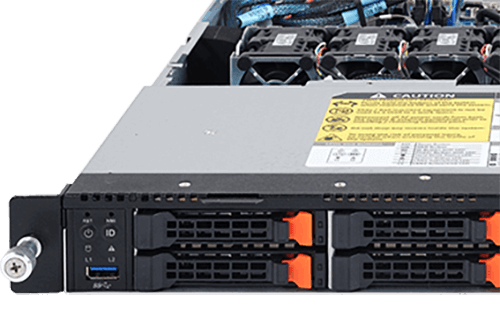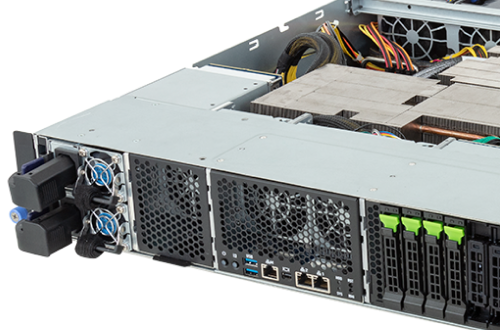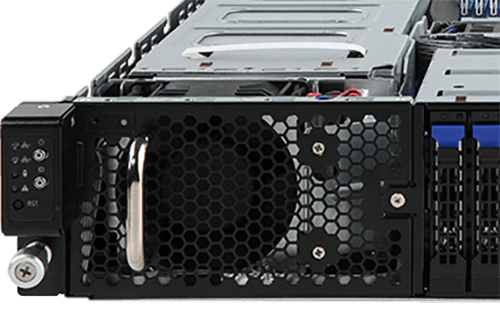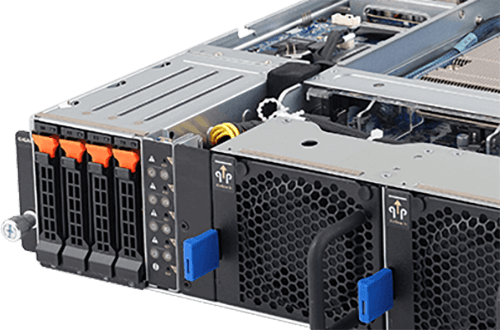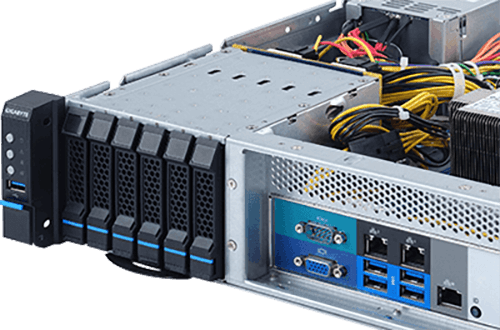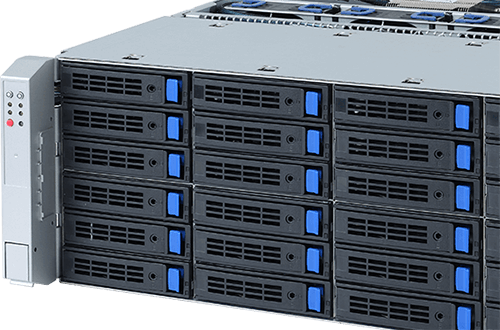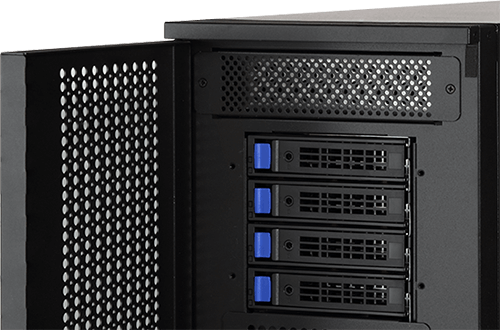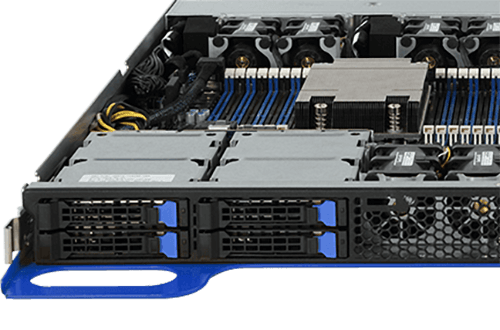Liquid Cooling | 液體冷卻
What is it?
As the name suggests, liquid cooling technology uses liquid (in this case, coolant) as a heat transfer mechanism. Two common liquid cooling technologies available on the market for servers are direct liquid cooling (DLC), also known as direct-to-chip (D2C) liquid cooling; and immersion cooling, which can be further subdivided into single-phase and two-phase immersion cooling. For more information about immersion cooling, it is recommended you take a look at our glossary entry or go straight to the dedicated solution page.
Direct liquid cooling helps the server dissipate heat through the use of sealed tubes (called cooling loops) filled with coolant. The cooling loops coil around key components inside the server chassis. Thermal energy is transferred from the components to the coolant through conductive copper plates, also called cold plates. The heated coolant is then circulated outside the server to a heat exchanger, which removes the heat from the coolant before piping it back into the server to repeat the cycle.
The heat exchanger may be installed in the same server rack as the liquid-cooled server, so that the heat is expelled directly into the hot aisle of an air-cooled data center. This is what is known as a liquid-to-air cooling setup, and it makes it easier for conventional data centers to dip a toe into liquid cooling without overhauling the entire infrastructure. Conversely, a liquid-to-liquid cooling setup transfers heated coolant from all the server racks to a centralized heat exchanger that is part of facility's liquid-based cooling loop. While this method is even more effective at dissipating heat, the server room will have to be designed from the outset to support liquid-cooled servers.
Direct liquid cooling helps the server dissipate heat through the use of sealed tubes (called cooling loops) filled with coolant. The cooling loops coil around key components inside the server chassis. Thermal energy is transferred from the components to the coolant through conductive copper plates, also called cold plates. The heated coolant is then circulated outside the server to a heat exchanger, which removes the heat from the coolant before piping it back into the server to repeat the cycle.
The heat exchanger may be installed in the same server rack as the liquid-cooled server, so that the heat is expelled directly into the hot aisle of an air-cooled data center. This is what is known as a liquid-to-air cooling setup, and it makes it easier for conventional data centers to dip a toe into liquid cooling without overhauling the entire infrastructure. Conversely, a liquid-to-liquid cooling setup transfers heated coolant from all the server racks to a centralized heat exchanger that is part of facility's liquid-based cooling loop. While this method is even more effective at dissipating heat, the server room will have to be designed from the outset to support liquid-cooled servers.
Why do you need it?
Liquid cooling is more efficient at heat transfer than traditional air-cooled systems, so it is often used for cooling servers that generate a high amount of heat, such as those that engage in high performance computing (HPC) to support the development of artificial intelligence (AI) or the creation of digital twins. Compared to air cooling, which requires fans and heat sinks to assist in heat dissipation, liquid cooling has no use for those components and also does not require extra space for air flow. All this helps to reduce the server's overall footprint, which can be used to greatly increase CPU and GPU density, so that more computing power can be deployed in a limited space. Efficient cooling can protect the servers from exceeding their intended TDP, which leads to greater reliability, higher availability, and even better chip performance. Liquid cooling technology also reduces energy consumption and improves the data center's PUE (Power Usage Effectiveness).
How is GIGABYTE helpful?
GIGABYTE is working with multiple industry partners to offer a variety of liquid cooling solutions for our server products, from single-phase immersion cooling to two-phase immersion cooling to direct liquid cooling. These solutions help our customers get the best performance out of their server solutions while adhering to the ideals of environmentally friendly green computing.
One recent example of GIGABYTE's DLC solution is the deployment of a new GIGABYTE HPC cluster in the German Aerospace Center. GIGABYTE's H261-Z60 Hyper-Converged Infrastructure (HCI) server from the H-Series of High Density Servers were combined with a CoolIT DLC system to build the new cluster. The solution provided up to twice the maximum computing power of competing products on the market, reduced the servers' footprint by 50%, and met the client's requirement of operating high-performance servers in an ambient temperature of 40°C with no air conditioning, in order to better meet the goals of energy efficiency and carbon reduction.
One recent example of GIGABYTE's DLC solution is the deployment of a new GIGABYTE HPC cluster in the German Aerospace Center. GIGABYTE's H261-Z60 Hyper-Converged Infrastructure (HCI) server from the H-Series of High Density Servers were combined with a CoolIT DLC system to build the new cluster. The solution provided up to twice the maximum computing power of competing products on the market, reduced the servers' footprint by 50%, and met the client's requirement of operating high-performance servers in an ambient temperature of 40°C with no air conditioning, in order to better meet the goals of energy efficiency and carbon reduction.
WE RECOMMEND
RELATED ARTICLES

Tech Guide
如何挑選您的AI伺服器?(下)記憶體、儲存裝置和其他元件
人工智慧盛行的當下,各種組織積極導入「AI伺服器」。技嘉科技最新發表的《科技指南》:「如何挑選您的AI伺服器?」,文章下半篇將介紹CPU和GPU以外的六個關鍵零組件。挑選合適元件可讓AI伺服器的性能達到顛峰,勝任人工智慧的相關工作。

AI & AIoT
帶您快速跟上人工智慧AI趨勢的十大問答
大家都在談人工智慧(AI),您是否也希望擁有基本的知識,參與這個話題的討論?別擔心,技嘉科技為您準備了介紹AI趨勢的十大問答,讓您能快速理解人工智慧的概念!

Tech Guide
如何挑選適當的伺服器冷卻方案? 技嘉科技《科技指南》系列文章
隨著科技進步,新一代的處理器使用更多電力、產出更多熱能。選購伺服器時,應當留意溫控問題,好的冷卻方案可確保伺服器正常運作,且不至於太耗電、或是需要頻繁的維修。 技嘉科技是高性能伺服器的領導品牌,本篇《科技指南》針對市面上廣泛使用的三種散熱方法(氣冷式、液冷式和浸沒式)逐一說明,並介紹技嘉的相關產品,協助您挑選最適合的解決方案。

Success Case
技嘉藉由單相浸沒式液冷技術 助力日本電信龍頭KDDI開發新世代資料中心
日本電信業界龍頭KDDI,因應新世代需求,積極研發對環境友善、便於移動的「貨櫃型浸沒式液冷小型資料中心」,此資料中心採用「單相浸沒式液冷」技術,可減少43%的總耗能,並將PUE改善至1.07以下。技嘉科技於浸沒式液冷解決方案擁有豐富的研發與部署經驗,提供機架式伺服器R282-Z93與R182-Z91,肩負資料中心管理節點和GPU運算節點的任務。技嘉伺服器的強項,是在有限空間內部署高密度、高擴充性的處理器配置,其優異的機構設計,能發揮第三代AMD EPYC™中央處理器及NVIDIA® GPU加速器的最大運算力。協助客戶開發「浸沒式液冷資料中心」,亦是技嘉深耕環境、社會與治理的ESG長期努力目標,技嘉攜手產業夥伴和客戶,積極實踐「創新科技,美化人生」的企業使命。

Success Case
半導體龍頭樹立資料中心新標竿 技嘉助力打造兩相浸沒式液冷機房
技嘉科技攜手合作夥伴,為全球晶圓代工龍頭建造「兩相浸沒式液冷機房」,樹立「節能HPC資料中心」的全新典範。「兩相浸沒式液冷」主要提供兩大優勢:第一,晶片運算效能增加10%以上,使半導體製程變得更有效率、良率更高;第二,機房總耗能降低30%,電力使用效率(PUE)改善至1.08以下,達成節能與效能同步升級之雙贏目標。透過技嘉的解決方案,除了滿足高效能運算的需求,重視永續發展的企業能更順利達成CSR、ESG與SDGs目標。「兩相浸沒式液冷機房」有望推廣至半導體供應鏈,進而擴大至其他產業,讓綠色製造和綠色計算資料中心普及,創造永續經營的新典範。

Success Case
德國航太中心的太空成就 技嘉伺服器也參與其中
德國航空太空中心(DLR)擴建資料中心機房,選擇技嘉科技GIGABYTE高密度伺服器搭配液冷散熱技術,在均溫40°C環境,不開空調降溫也能維持穩定運作,有限空間內高效處理龐大複雜的太空資料。

Cooling
規劃資料中心冷卻方案時 不可不知的5個關鍵知識

Cooling
三個簡單步驟,輕鬆挑選伺服器冷卻方案







